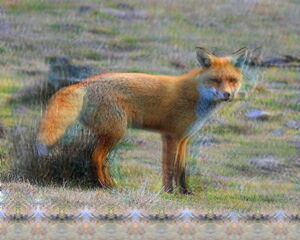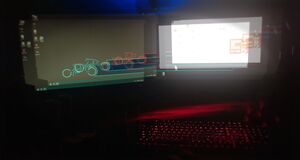Double vision
Double vision (also known as diplopia) is medically defined as the experience of seeing a single object as a separate image by each eye[1][2], similar to that which occurs when one crosses their eyes. Depending on the intensity, this effect can result in a reduced ability to function and perform basic tasks which necessitate the use of sight.
The effect can easily be suppressed by closing one eye. This suggests that double vision may occur when the brain overlays the data received from both eyes on top of each other incorrectly, without merging the information into a singular 3-dimensional image as it normally would during everyday life.
This effect is capable of manifesting across the 3 different levels of intensity described below:
- Subtle - At the lowest level, double vision is subtle and mostly ignorable in a manner which, although obviously present, is still not intense enough to render the person incapable of perceiving visual details necessary for tasks such as reading text or crossing a busy street.
- Distinct - At this level, double vision becomes intense enough to result in extreme difficulty performing tasks which require the perception of fine details, such as reading. However, the perception of large-scale details such as the person's general environment tends to remain readily perceivable with both eyes open.
- Intense - At the highest level, double vision becomes so intense that the person will no longer be able to accurately perceive small and large-scale visual details of their environment. This will necessitate that the person closes one of their eyes at all time in order to function as they would sober.
Double vision is often accompanied by other coinciding effects such as visual acuity suppression and pattern recognition suppression. This effect is most commonly induced under the influence of moderate dosages of depressant and dissociative compounds, such as alcohol, quetiapine, ketamine, and DXM.[3] However, it can also occur much less consistently under a wide range of other classes of compounds such as hallucinogens, stimulants, anticholingerics, SSRI's, opioids, GABAergics, and cannabinoids.
Image examples
| Caption | |
|---|---|
 | Desktop double vision by Chelsea Morgan |
 | Double vision in a kitchen by Anonymous |
 | Double vision on a fox by Arnold Layne |
 | Double vision on a PC by Arnold Layne |
 | Double vision at a desk by Anonymous |
Psychoactive substances
Compounds within our psychoactive substance index which may cause this effect include:
- 2-Fluorodeschloroketamine
- 3,4-CTMP
- 3-Cl-PCP
- 3-HO-PCP
- 3-MMC
- 3-MeO-PCE
- 3-MeO-PCMo
- 3-MeO-PCP
- 4-MeO-PCP
- Acetylfentanyl
- Alcohol
- Amanita muscaria
- Benzydamine
- Codeine
- Datura
- Deschloroketamine
- Desomorphine
- Dextromethorphan
- Dihydrocodeine
- Diphenhydramine
- Diphenidine
- Ephedrine
- Ephenidine
- Fentanyl
- Gaboxadol
- HXE
- Heroin
- Ketamine
- Kratom
- Lisdexamfetamine
- MDEA
- MDMA
- MXiPr
- Mebroqualone
- Memantine
- Methadone
- Methamphetamine
- Methaqualone
- Methoxetamine
- Methoxphenidine
- Morphine
- Myristicin
- Nitrous
- O-PCE
- Opioids
- PCE
- PCP
- PMA
- PMMA
- Pregabalin
Experience reports
Annectdotal reports which describe this effect with our experience index include:
- Experience: 105mg Ephenidine - An Intense Emotional Experience
- Experience:25mg Deschloroketamine - My first time orally dosing DCK
- Experience:260 mg Ketamine (insufflated) - Lost in Paisley
- Experience:2mg 25C-NBOMe - Experimental trip to test personal limits of NBOMes
- Experience:2mg Etizolam & N2O - "Hippy Crack" Indeed
- Experience:30mg (smoked) DMT - The Monolith
- Experience:40mg Zolpidem / 20mg Diazepam - Please Don't Do This
- Experience:60mg Zolpidem - A Delirious Adventure
- Experience:700mg - To the dextroverse.
- Experience:A combination of DOC, 5-MAPB, 5-MeO-DMT, ETH-LAD, Cannabis, Pentedrone
- Experience:Datura Alcoholic Tincture
- Experience:Ephenidine:185mg - A Weird and Rewarding Trip
- Experience:LSA (20 HWBR seeds) – A pleasant adventure with a harsh body load
See also
- Responsible use
- Subjective effects index
- Dissociatives - Subjective effects
- Deliriants - Subjective effects
- Psychedelics - Subjective effects
External links
References
- ↑ "double vision". APA Dictionary of Psychology. Retrieved 20 May 2022.
- ↑ Marsh, A. (1979). "Visual Hallucinations During Hallucinogenic Experience and Schizophrenia". Schizophrenia Bulletin. 5 (4): 627–630. doi:10.1093/schbul/5.4.627. ISSN 0586-7614.
- ↑ B.Sc., Joanne L. Smith; Buncic, J. Raymond (2018). "Drugs Which Can Affect near Vision: A Useful List". American Orthoptic Journal. 49 (1): 180–190. doi:10.1080/0065955X.1999.11982210. ISSN 0065-955X.